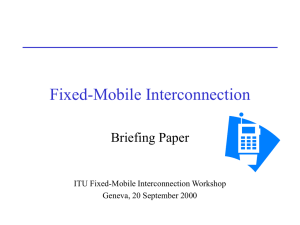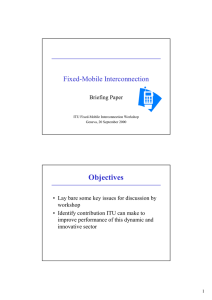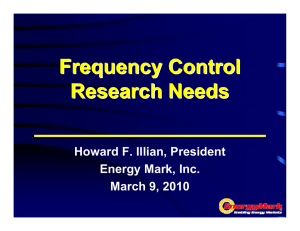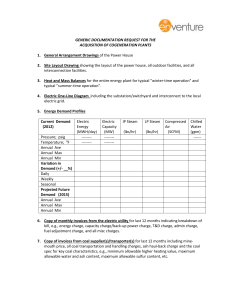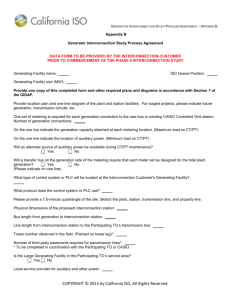F -M I
advertisement
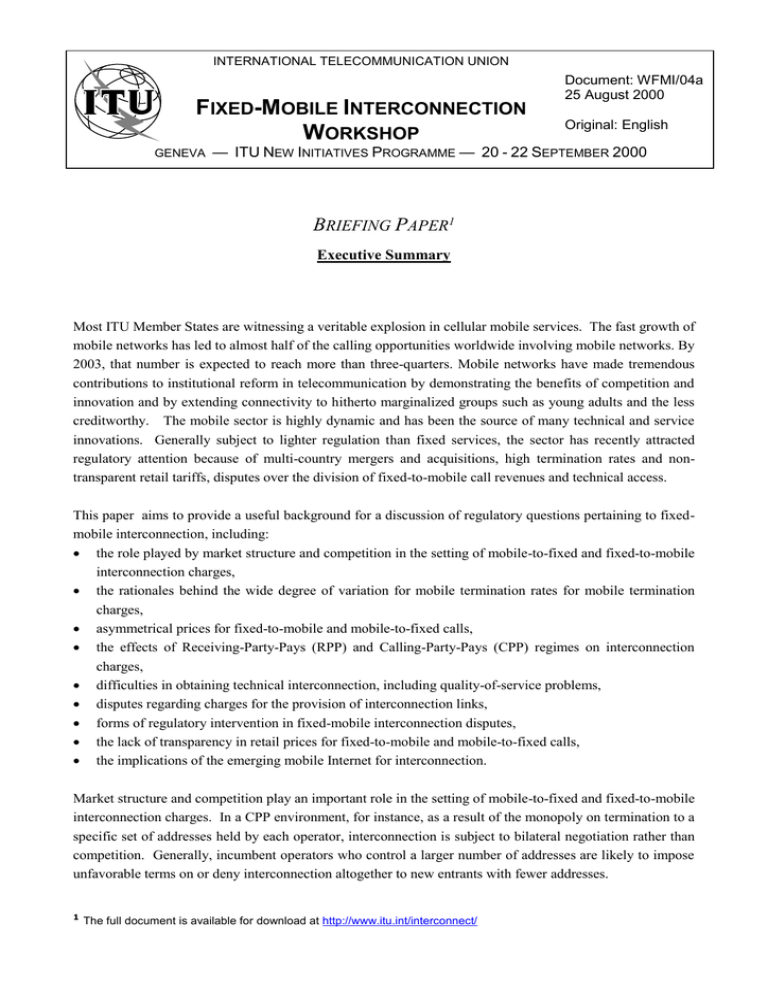
INTERNATIONAL TELECOMMUNICATION UNION FIXED-MOBILE INTERCONNECTION WORKSHOP GENEVA Document: WFMI/04a 25 August 2000 Original: English — ITU NEW INITIATIVES PROGRAMME — 20 - 22 SEPTEMBER 2000 BRIEFING PAPER1 Executive Summary Most ITU Member States are witnessing a veritable explosion in cellular mobile services. The fast growth of mobile networks has led to almost half of the calling opportunities worldwide involving mobile networks. By 2003, that number is expected to reach more than three-quarters. Mobile networks have made tremendous contributions to institutional reform in telecommunication by demonstrating the benefits of competition and innovation and by extending connectivity to hitherto marginalized groups such as young adults and the less creditworthy. The mobile sector is highly dynamic and has been the source of many technical and service innovations. Generally subject to lighter regulation than fixed services, the sector has recently attracted regulatory attention because of multi-country mergers and acquisitions, high termination rates and nontransparent retail tariffs, disputes over the division of fixed-to-mobile call revenues and technical access. This paper aims to provide a useful background for a discussion of regulatory questions pertaining to fixedmobile interconnection, including: the role played by market structure and competition in the setting of mobile-to-fixed and fixed-to-mobile interconnection charges, the rationales behind the wide degree of variation for mobile termination rates for mobile termination charges, asymmetrical prices for fixed-to-mobile and mobile-to-fixed calls, the effects of Receiving-Party-Pays (RPP) and Calling-Party-Pays (CPP) regimes on interconnection charges, difficulties in obtaining technical interconnection, including quality-of-service problems, disputes regarding charges for the provision of interconnection links, forms of regulatory intervention in fixed-mobile interconnection disputes, the lack of transparency in retail prices for fixed-to-mobile and mobile-to-fixed calls, the implications of the emerging mobile Internet for interconnection. Market structure and competition play an important role in the setting of mobile-to-fixed and fixed-to-mobile interconnection charges. In a CPP environment, for instance, as a result of the monopoly on termination to a specific set of addresses held by each operator, interconnection is subject to bilateral negotiation rather than competition. Generally, incumbent operators who control a larger number of addresses are likely to impose unfavorable terms on or deny interconnection altogether to new entrants with fewer addresses. 1 The full document is available for download at http://www.itu.int/interconnect/ In those special circumstances where incumbents are subject to mandatory cost-based interconnection, regulatory agencies do not intervene in the setting of termination charges, charges are passed on to fixed customers under CPP, and there is incumbent ownership of mobile operators, a different outcome of excessive fixed-to-mobile termination charges may be seen. Consequently, the prices of calls to mobile phones from fixed customers tend to be significantly higher than calls to fixed phones by mobile customers in CPP environments. Fixed-mobile interconnection, especially in developing countries, has been plagued by the difficulties endemic to interconnection arrangements with incumbents, in the form of constrictive provisions for the establishment of points of interconnection that affect quality-of-service as well as interconnection payments. Overarching principles such as those in the WTO Regulatory Reference Paper and the European Commission's Interconnection Directive are useful but active intervention by National Regulatory Agencies (NRAs) is essential for their satisfactory resolution. Given their limited resources, NRAs have to develop effective rules to prioritize intervention, manage the complex interactions among large numbers of stakeholders and enforce their decisions. The analysis suggests that determinations of operators deemed to have significant market power (SMP) based on calling opportunities may be superior to the conventional approach based on market share. The European Union has recently proposed a different criterion based on market dominance. Simplification of the regulatory process may be achieved by means such as the adoption of the Most Favored Nation (MFN) principle from trade negotiations. Also, transparency and the use of alternative dispute resolution techniques may facilitate enforcement. Further efforts are necessary to improve cost methodologies for mobile interconnection pricing. The likely shift to volume-based pricing in the emergent packet switched services is likely to require a qualitative shift from the methodologies associated with circuit switched networks. Dissemination of termination charges and other interconnection-related information by the ITU can be of great assistance to fledgling NRAs, especially in light of the limitations of cost studies in the dynamic mobile sector and the increasing value placed on benchmarking.
